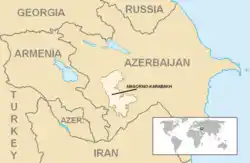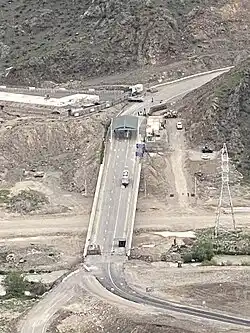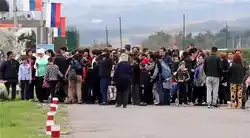
The Nagorno-Karabakh conflict is a longstanding dispute between the countries of Armenia and Azerbaijan in the Caucasus over the Nagorno-Karabakh region. The region has historically been populated by ethnic Armenians, but has formed part of Azerbaijan politically. Dissent amongst the Armenian majority led to the First Nagorno-Karabakh War between 1988 and 1994. This resulted in the establishment of the de-facto independent Republic of Artsakh. A brief Second Nagorno-Karabakh War occurred between late September and mid-November 2020. It ended in a stalemate and an internationally-brokered ceasefire. The latest episode in the conflict came in a two-day operation on the 19th and 20th of September 2023, in the course of which Azerbaijan reoccupied the territory and the breakaway Republic of Artsakh was brought to an end. This led to the mass exodus of almost the entire population of the region, recorded as just over 145,000 people in 2015, primarily over the border into Armenia.[1]
Research your ancestors on MyHeritage
Nagorno-Karabakh conflict chronology of eventsNagorno-Karabakh conflict chronology of events
The Nagorno-Karabakh region lies near the wider border region between Armenia and Azerbaijan in the Caucasus. Armenia and Azerbaijan have always had overlapping jurisdictions and claims on land in the Caucasus owing to pockets of ethnic settlement. Most notably, the Nakhichevan enclave is a part of Azerbaijan which is cut off from the rest of the country and otherwise surrounded by Armenia, Iran and Turkey.[2] The Nagorno-Karabakh region is another problematic region, in that it lies within the wider Azerbaijan region, but had a major Armenian population during the twentieth century. Tensions between Armenians and Azerbaijanis over control of the region emerged as the Ottoman Empire collapsed at the end of the First World War, but communist victory in the Russian Civil War and the establishment of firm control over the region by the Soviet Union saw ethnic tensions dampen down until the end of the Cold War.[3]
With the advent of the reform policies of Mikhail Gorbachev within the USSR from 1985 onwards and the gradual disintegration of the Soviet Union in the late 1980s and early 1990s, ethnic tensions between Armenians and Azerbaijanis re-emerged here. The result was the First Nagorno-Karabakh War, fought between 1988 and 1994. This morphed in time into a wider conflict between the new states of Armenia and Azerbaijan that emerged in 1991 as the USSR was fully dismantled. In this first major conflict over the region, the Armenians were victorious, with the Republic of Artsakh established as an Armenian breakaway state ruling Nagorno-Karabakh.[4] The vast majority of ethnic Azerbaijanis left the region and it would remain an autonomous state, though one with limited international recognition, for over quarter of a century.[5]

Tensions flared again in 2020 as Azerbaijan, which is emerging as a regional power in the Caucasus, sought to reignite the conflict and claim the Nagorno-Karabakh region back. The Second Nagorno-Karabakh War lasted just 44 days between the 27th of September and the 10th of November. The clash was a victory for Azerbaijan, which managed to claim back more than half of the disputed territory, but it was not a complete victory. When a ceasefire was brokered by several international parties including Russia, it stipulated that the Republic of Artsakh would remain in existence. Russian peacekeepers were established on the ground, particularly along the Lachin Corridor, a road that connects the Nagorno-Karabakh region to Armenia travelling through Azerbaijan. Without this corridor, Nagorno-Karabakh would be surrounded by Azerbaijan and cut off from resupply from Armenia.[6]
The most recent stage in the conflict occurred on the 19th and 20th of September 2023 when Azerbaijani forces, in violation of the 2020 ceasefire agreement, moved into Nagorno-Karabakh and took over the rest of the territory there, bringing the Republic of Artsakh to an end in the process. This came after a sustained period of disruption of the Lachin Corridor and other supply routes into Nagorno-Karabakh by the Azerbaijani government and military, actions which were inducing huge supply problems and threatening famine in the beleaguered enclave. With the 2023 incursion, it would seem as though Azerbaijan has emerged victorious in the three and a half decades’ long conflict, but there may well be another chapter in the Nagorno-Karabakh conflict in years to come.[7]
Migration caused by and demographic impact of the conflictMigration caused by and demographic impact of the conflict

The Nagorno-Karabakh conflict has led to two different waves of migration that have had major demographic implications for the region. When the Nagorno-Karabakh region was taken over by ethnic Armenians and the Republic of Artsakh was established back in the early 1990s, a mass exodus of over half a million ethnic Azerbaijanis to elsewhere in Azerbaijan took place. These people and their children have lived in Azerbaijan for the most part over the last three decades. Since the 2023 re-conquest of Nagorno-Karabakh, some have been making their way back to the region they left in the early 1990s.[8]
This opposite is the case for ethnic Armenians in the region. A census was held in the Republic of Artsakh in 2015. This revealed a population of just over 145,000 people, of which more than 99% were registered as being ethnic Armenians, along with a few hundred Russians. The 2023 offensive by Azerbaijan and the takeover of the Nagorno-Karabakh region led to the mass exodus of virtually the entire population from the now conquered Republic of Artsakh. Unsurprisingly, a huge proportion of the refugees fled to neighboring Armenia where many have established businesses in the capital Yerevan. However, in a country of less than three million people, the government is struggling to integrate such a large refugee influx and it is suspected that many will head for greener pastures in the months and years to come elsewhere in Europe.[9]
See alsoSee also
Explore more about the Nagorno-Karabakh conflictExplore more about the Nagorno-Karabakh conflict
- Nagorno-Karabakh Profile at BBC News
- Nagorno-Karabakh Conflict at Council on Foreign Relations
- Armenia, Voters List 2019 records collection on MyHeritage
- Former Russian Empire, World War I Casualties records collection on MyHeritage
References
- ↑ https://www.cfr.org/global-conflict-tracker/conflict/nagorno-karabakh-conflict
- ↑ https://apnews.com/article/azerbaijan-armenia-nagorno-karabakh-nakhchivan-51113f0439b51bbeeb7009bf067f205b
- ↑ https://www.bbc.com/news/world-europe-18270325
- ↑ https://www.fpri.org/article/2024/01/a-frozen-conflict-boils-over-nagorno-karabakh-in-2023-and-future-implications/
- ↑ https://www.crisisgroup.org/content/nagorno-karabakh-conflict-visual-explainer
- ↑ https://www.politico.eu/article/nagorno-karabakh-conflict-azerbaijan-armenia-south-caucasus-russia/
- ↑ https://www.bbc.com/news/world-europe-66852070
- ↑ https://www.theguardian.com/world/2023/oct/08/what-azeris-lost-in-nagorno-karabakh-conflict
- ↑ https://www.rferl.org/a/karabakh-refugees-armenia-welcome-struggling-azerbaijan/32743624.html

